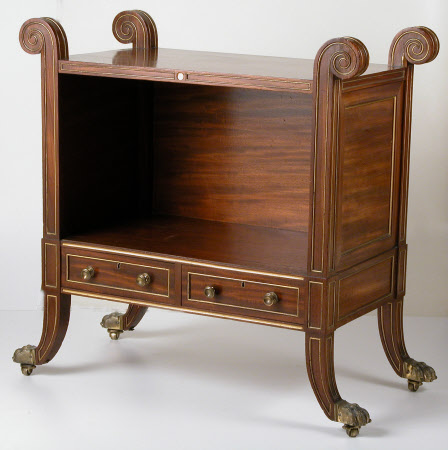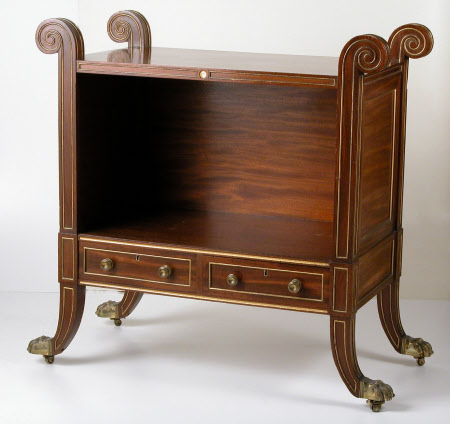The Stourhead Music Stands
Thomas Chippendale II (1749 - 1822)
Category
Furniture
Date
1812
Materials
Mahogany, parcel gilt, oak and mahogany construction, brass
Measurements
90 x 91 x 46.5 cm
Place of origin
London
Order this imageCollection
Stourhead, Wiltshire
NT 731582
Summary
A pair of mahogany and parcel gilt music cabinets, by Thomas Chippendale the Younger (1749-1822) London 1812. Commissioned for the Music Room at Stourhead by Sir Richard Colt Hoare. With an open recess above a pair of frieze drawers held by moulded square section moulded columns with scrolled capitals and sabre legs, raised on lion's paw brass castors, the back and sides panelled.
Full description
Chippendale's account dated August 15th 1812 '2 Mahy Music stands with scrowl heads the feet panelld and also the 2 drawers, ends and back & finishd in Matt Gold £26-' Thomas Chippendale the Younger at Stourhead Sir Richard Colt Hoare employed Thomas Chippendale the Younger (1749-1822) from 1795 to 1820 to supply furniture and furnishings for Stourhead in Wiltshire. The accounts submitted for his work are the largest known archive relating to Chippendale’s work. Out of the 163 pieces of furniture described in the accounts, 103 are still in the house, mostly in the rooms for which they were made. There was a fire in 1902 which destroyed the central part of Stourhead but fortunately most of the pictures and furniture from the ground floor were saved, the majority of the contents of the upper floors were destroyed. Chippendale the Younger worked with his father Thomas Chippendale (1718-1779) for many years before the latter died. Much of the work he produced in the 1780s and 1790s continued the styles and techniques associated with the Chippendale firm. During these years he was completing or continuing commissions that the firm had been involved with including Harewood house, Nostell Priory, and Burton Constable amongst others. The furniture supplied for Stourhead shows the continued high quality and attention to detail that was expected from the Chippendale workshops, linked with simplicity of decoration and clarity of line. For further discussion and extensive published research see: Goodison, Judith ‘The life and work of Thomas Chippendale Junior’ PWP 2017 Goodison, Judith ‘Thomas Chippendale the Younger at Stourhead’ Furniture History Society 2005 (Vol. 41) pp. 57-116 Gilbert, Christopher ‘The life and work of Thomas Chippendale’ London 1978 Vol.1 pp.235, 267 Beard, Geoffrey & Gilbert, Christopher ‘The Dictionary of English Furniture Makers, 1660-1840’ Furniture History Society 1986 pg.169 James Weedon (January 2018)
Provenance
By Thomas Chippendale the Younger (1749-1822) London. Commissioned for the Music Room at Stourhead by Sir Richard Colt Hoare in 1812
Marks and inscriptions
Items bear adhesive labels on underside markes 'A' and 'B'
Makers and roles
Thomas Chippendale II (1749 - 1822), cabinet maker
References
Goodison, 2005: Judith Goodison. “Thomas Chippendale the younger at Stourhead.” Furniture History 31 (2005): pp.57-116, pp. 57-116 Gilbert, 1978: Christopher Gilbert. The life and work of Thomas Chippendale. London: Studio Vista: Christie’s, 1978., pp. 235, 267 Beard and Gilbert, 1986: Geoffrey Beard and Christopher Gilbert (ed), Dictionary of English Furniture Makers 1660-1840, 1986, pg.169 Goodison, 2017: Judith Goodison, The Life and Work of Thomas Chippendale Junior, PWP London & New York 2017

